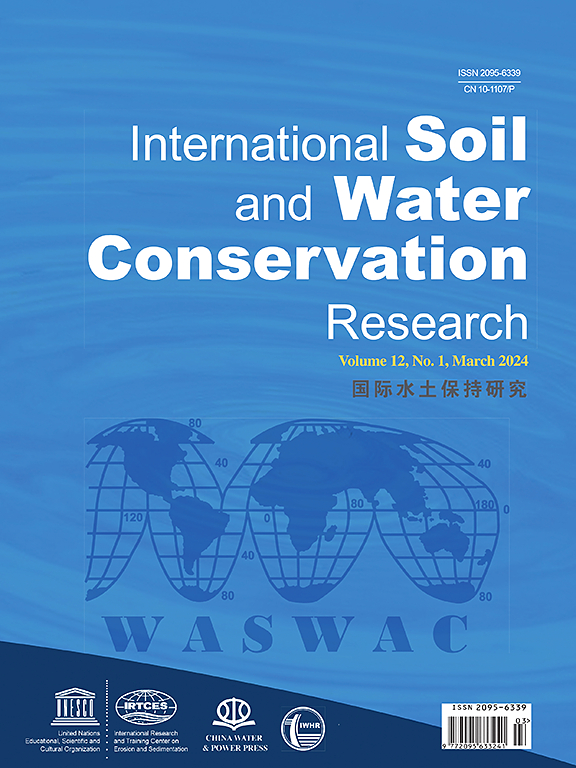Straw incorporation regulates rill erosion processes: Revealing multi-timescale hysteresis between runoff and sediment concentration in brown soil
IF 7.3
1区 农林科学
Q1 ENVIRONMENTAL SCIENCES
International Soil and Water Conservation Research
Pub Date : 2025-07-01
DOI:10.1016/j.iswcr.2025.06.007
引用次数: 0
Abstract
The rill erosion process in sloping farmland after straw incorporation is different from that under traditional tillage, including complex variations and hysteresis in runoff and sediment concentration. However, the hysteresis of original runoff and sediment concentration series is not enough to show the hidden multi-timescale information. Different straw incorporation strategies have varying degrees of change to the hysteresis on runoff and sediment content. The purpose of this study was to systematically identify the hysteresis characteristics and differences of runoff and sediment concentration in multi-timescales on rill erosion, and to reveal the effects of straw length, incorporation depth, and straw amount on hysteresis. In this study, scouring experiments were carried out in runoff plots for brown soil under nine maize straw incorporation treatments, i.e., two gradients of straw length (<3, 3−6 cm), incorporation depth (15, 20 cm), straw amount (4000, 8000 kg ha−1), and traditional tillage without straw (CK). The signal decomposition method was used to extract runoff and sediment concentration components at multi-timescales for rill erosion, and hysteresis loops and cross-correlation were applied to analyze the multi-timescale hysteresis relationship of runoff and sediment concentration. The results showed that increases in straw length and straw amount could reduce runoff and sediment and increase runoff start time. The CK had the hysteresis loop with anticlockwise type, and the runoff and sediment concentration had complex hysteresis phenomenon under straw incorporation. The <3 cm straw length treatments exhibited a tendency for clockwise hysteresis loops. This was attributed to the limited supply of sediment during the later erosion stages. In addition, multiscale cross-correlation showed more detailed hysteresis information than the hysteresis loop of the original series, and better explained the variation of sediment concentration. In the >0.3 high-frequency component, the CK exhibited sediment concentration leading runoff (1−3 min), while the 8000 kg ha−1 straw amount treatments intensified complex fluctuations in runoff and sediment, demonstrating variable leads or lags for the sediment concentration. At the sub-event scale, the 3−6 cm straw length treatments resulted in sediment concentration leading runoff, showing a hysteresis similar to that of the event scale. Clarifying the multi-timescale hysteresis of runoff and sediment helps improve understanding of runoff and sediment dynamics in rill erosion processes under straw incorporation for brown soil.
秸秆掺入调节细沟侵蚀过程:揭示棕色土壤径流和泥沙浓度之间的多时间尺度滞后
秸秆还田后坡耕地细沟侵蚀过程与传统耕作方式不同,径流和泥沙含量变化复杂,具有滞后性。但是,原始径流和泥沙浓度序列的滞后性不足以显示隐藏的多时间尺度信息。不同秸秆还田策略对径流和泥沙的滞后性有不同程度的影响。本研究旨在系统识别多时间尺度径流和泥沙浓度对细沟侵蚀的滞后特征和差异,揭示秸秆长度、入渗深度和秸秆用量对滞后的影响。本研究采用9种玉米秸秆还田处理,即秸秆长度(3、3 ~ 6 cm)、还田深度(15、20 cm)、秸秆用量(4000、8000 kg ha ~ 1)和传统无秸秆耕作(CK)两种梯度,对棕壤径流地块进行了冲刷试验。采用信号分解方法提取细沟侵蚀多时间尺度的流沙分量,利用滞回线和相互关系分析径流和泥沙的多时间尺度滞回关系。结果表明,增加秸秆长度和秸秆量可以减少径流和泥沙,延长径流启动时间。对照区存在逆时针型滞回环,秸秆还田条件下径流和泥沙浓度存在复杂的滞回现象。秸秆长度为3 cm的处理呈现顺时针迟滞回线的趋势。这是由于后期侵蚀阶段沉积物供应有限。此外,多尺度相互关比原始序列的滞回线显示出更详细的滞回信息,更好地解释了泥沙浓度的变化。在>;0.3高频分量中,CK表现出泥沙浓度主导径流(1 ~ 3 min),而8000 kg ha - 1秸秆量处理则加剧了径流和泥沙的复杂波动,对泥沙浓度表现出不同的领先或滞后。在次事件尺度上,3 ~ 6 cm秸秆长度处理导致泥沙浓度主导径流,表现出与事件尺度相似的滞后性。阐明径流泥沙的多时间尺度滞后性,有助于进一步认识秸秆还田条件下褐土细沟侵蚀过程的径流泥沙动力学。
本文章由计算机程序翻译,如有差异,请以英文原文为准。
求助全文
约1分钟内获得全文
求助全文
来源期刊

International Soil and Water Conservation Research
Agricultural and Biological Sciences-Agronomy and Crop Science
CiteScore
12.00
自引率
3.10%
发文量
171
审稿时长
49 days
期刊介绍:
The International Soil and Water Conservation Research (ISWCR), the official journal of World Association of Soil and Water Conservation (WASWAC) http://www.waswac.org, is a multidisciplinary journal of soil and water conservation research, practice, policy, and perspectives. It aims to disseminate new knowledge and promote the practice of soil and water conservation.
The scope of International Soil and Water Conservation Research includes research, strategies, and technologies for prediction, prevention, and protection of soil and water resources. It deals with identification, characterization, and modeling; dynamic monitoring and evaluation; assessment and management of conservation practice and creation and implementation of quality standards.
Examples of appropriate topical areas include (but are not limited to):
• Conservation models, tools, and technologies
• Conservation agricultural
• Soil health resources, indicators, assessment, and management
• Land degradation
• Sustainable development
• Soil erosion and its control
• Soil erosion processes
• Water resources assessment and management
• Watershed management
• Soil erosion models
• Literature review on topics related soil and water conservation research
 求助内容:
求助内容: 应助结果提醒方式:
应助结果提醒方式:


